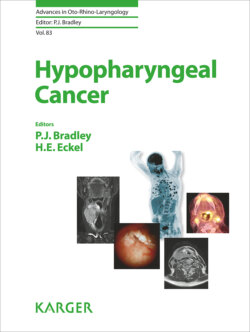Читать книгу Hypopharyngeal Cancer - Группа авторов - Страница 16
На сайте Литреса книга снята с продажи.
Global Life Style Risk Factors
ОглавлениеThe large variation that exists in UADT cancers is mainly attributed to the disparity that exists in the populations’ exposure to the major environmental and social behavioural risk factors, which are mainly use of tobacco, consumption of alcohol, and inadequate intake of fruits and vegetables [37–42].
The causes of hypopharyngeal cancers are most probably multifactorial [35]. While major studies have been carried out on larynx cancer, it has been assumed that because the hypopharynx is anatomically proximal and related to the larynx and both are exposed to similar risk factors, they have been considered to be traditionally similar and therefore reported together [28]. The factors that lead to someone developing any disease on a particular day are likely to have their roots in a complex chain of environmental events that may have begun years previously, which in turn were shaped by broader socioeconomic determinants. Most of the risks cannot be disentangled in order to be considered in isolation, as they act at different levels, which vary over time [43].
The discrepancy in estimation of risks among the many reported studies of the known at-risk-factors – smoking and alcohol – may be due to the fact that smoking factors differ largely and drinking patterns relating to overall level of alcohol consumption, choice of alcohol beverages, differences by gender and age and temporal variations, differ among and within societies all over the world. Adding the effect of betel quid (areca nut) chewing to drinking and smoking becomes more complicated in elucidating their combined carcinogenic effect (Fig. 2) [44].
Other epidemiological studies have shown that employment in industries with occupational exposure to wood dust, asbestos, acid mists or solvents and in industries related to the manufacturing of textiles and leather is associated with an increased risk of UADT cancers [45, 46]. It has been observed that there is an association between socioeconomic status and UADT cancer, and low socioeconomic status has been independently linked to an increased incidence and poorer survival [47].
Fig. 2. Modifiable risk-factor data collection from patients diagnosed with hypopharyngeal cancer.
In a review of 15 reported studies based in Europe, North America and some parts of South America, data on hypopharyngeal cancer was analysed for body mass index, smoking and alcohol consumption [40]. There was increased odds ratios for both sexes (women and men) with lower body mass index, and the strength of smoking pack years diminished with increasing cigarettes per day, that is, for fixed pack-years, higher cigarettes per day for shorter duration was less deleterious than lower cigarettes per day for longer duration, while the strength of drink-years association increased with drinks-per day > 10. Smoking is more strongly linked with larynx cancer, whereas drinking of alcohol is more strongly linked with hypopharyngeal cancer [41].
